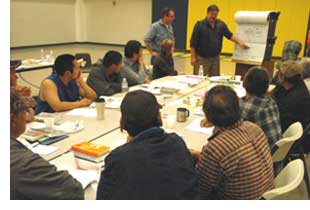Emergency Planning, Management, and Response:

It is
important to know what hazardous substances are stored in your community and what hazardous substances may travel through your
community. Within the four-phase emergency management cycle (prevention, preparedness, response, and recovery), local planning
for emergency events -
preparedness - can greatly affect the chain of events following a disaster.
Local Emergency Planning Committees (LEPC)
work to understand chemical hazards in the community, develop emergency plans in case of an accidental release, and look for
ways to prevent chemical accidents. LEPCs are made up of emergency management agencies, responders, industry and the public.
Hazardous materials pose unique evacuation challenges because the type of material determines the appropriate response; however,
many response plans do not account for this difference. For example chlorine gas sinks lower than air and concentrates in valleys;
other gases rise to higher elevations. Response plans and training exercises need to include decision paths that consider the
effects of materials and the most appropriate responses to protect the population.
Evacuation issues that should be considered are how to determine whether to shelter in place or evacuate, what routes would protect
or harm people given different hazardous materials and how they behave in a spill, and the role of transportation professionals in
working with emergency responders to manage evacuation.
Emergency management and incident response plans and activities should be prepared by communities and facilities based on the
hazards they may need to address. However, there are numerous templates and example of plans that can help planners with the task
of writing plans.
What kind of emergencies, conflicts, or disasters may your community have to respond to?
- Natural events (tidal waves, earthquakes, volcanic eruption, avalanche, prolonged extreme heat or cold, drought, flood, hurricanes, etc.)
- Chemical incidents (oil spill, hazardous substance release)
- Radiological incidents
- Deliberate events (riot, enemy or terrorist attack, intentional release of chemicals, biological agents, and radiological materials)
- Disease outbreaks
- Explosion
- Fire
The US Department of Homeland Security, Federal Emergency Management Agency (FEMA), provides a systematic, proactive approach to
guide departments and agencies at all levels of government, nongovernmental organizations, and the private sector to work seamlessly
to prevent, protect against, respond to, recover from, and mitigate the effects of incidents, regardless of cause, size, location,
or complexity, in order to reduce the loss of life property and harm to the environment through the
National Incident Management System (NIMS).
The U.S. Environmental Protection Agency coordinates and implements a wide range of activities to ensure that adequate and timely
response measures are taken in communities affected by hazardous substances and oil releases where state and local first responder
capabilities have been exceeded or where additional support is needed. EPA's emergency response program responds to chemical, oil,
biological, and radiological releases and large-scale national emergencies, including homeland security incidents.
The Emergency Planning and Community Right-to-Know Act (EPCRA) of 1986 was created to help communities plan for emergencies involving
hazardous substances. The Act establishes requirements for federal, state and local governments, Indian tribes, and industry regarding
emergency planning and &Community Right-to-Know& reporting on hazardous and toxic chemicals.
State Emergency Response Commission (SERC)
oversee the implementation of EPCRA requirements in each state.
The Spill Prevention, Control, and Countermeasure (SPCC) Rule:
The Spill Prevention, Control, and Countermeasure (SPCC) rule includes requirements for oil spill prevention, preparedness, and
response to prevent oil discharges to navigable waters and adjoining shorelines. The rule requires specific facilities to prepare,
amend, and implement SPCC Plans. The SPCC rule is part of the
Oil Pollution Prevention regulation,
which also includes the
Facility Response Plan (FRP) rule.
 ITEP
ITEP It is
important to know what hazardous substances are stored in your community and what hazardous substances may travel through your
community. Within the four-phase emergency management cycle (prevention, preparedness, response, and recovery), local planning
for emergency events - preparedness - can greatly affect the chain of events following a disaster.
It is
important to know what hazardous substances are stored in your community and what hazardous substances may travel through your
community. Within the four-phase emergency management cycle (prevention, preparedness, response, and recovery), local planning
for emergency events - preparedness - can greatly affect the chain of events following a disaster.